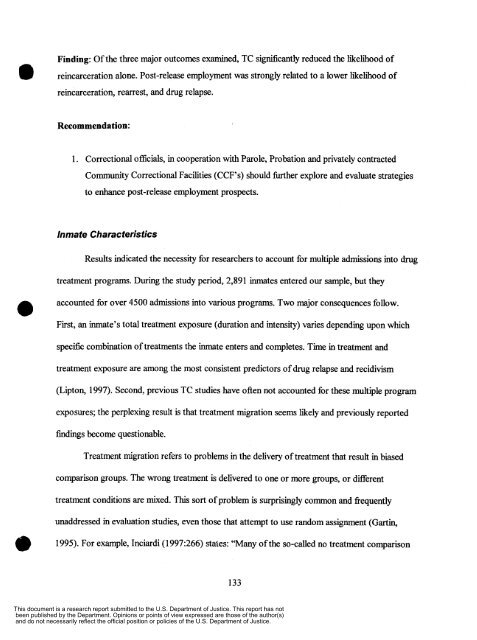0 - National Criminal Justice Reference Service
0 - National Criminal Justice Reference Service
0 - National Criminal Justice Reference Service
You also want an ePaper? Increase the reach of your titles
YUMPU automatically turns print PDFs into web optimized ePapers that Google loves.
Finding: Of the three major outcomes examined, TC sigmficantly reduced the likelihood of<br />
reincarceration alone. Post-release employment was strongly related to a lower likelihood of<br />
reincarceration, rearrest, and drug relapse.<br />
Recommendation:<br />
1. Correctional officials, in cooperation with Parole, Probation and privately contracted<br />
Community Correctional Facilities (CCF’s) should mher explore and evaluate strategies<br />
to enhance post-release employment prospects.<br />
Inmate Characteristics<br />
Results indicated the necessity for researchers to account for multiple admissions into drug<br />
treatment programs. During the study period, 2,891 inmates entered our sample, but they<br />
0<br />
accounted for over 4500 admissions into various programs. Two major consequences follow.<br />
First, an inmate’s total treatment exposure (duration and intensity) varies depending upon which<br />
specific combination of treatments the inmate enters and completes. Time in treatment and<br />
treatment exposure are among the most consistent predictors of drug relapse and recidivism<br />
(Lipton, 1997). Second, previous TC studies have often not accounted for these multiple program<br />
exposures; the perplexing result is that treatment migration seems likely and previously reported<br />
findings become questionable.<br />
Treatment migration refers to problems in the delivery of treatment that result in biased<br />
comparison groups. The wrong treatment is delivered to one or more groups, or different<br />
treatment conditions are mixed. This sort of problem is surprisingly common and fiequently<br />
unaddressed in evaluation studies, even those that attempt to use random assignment (Gartin,<br />
1995). For example, Inciardi (1997:266) states: “Many of the so-called no treatment comparison<br />
133<br />
This document is a research report submitted to the U.S. Department of <strong>Justice</strong>. This report has not<br />
been published by the Department. Opinions or points of view expressed are those of the author(s)<br />
and do not necessarily reflect the official position or policies of the U.S. Department of <strong>Justice</strong>.
















